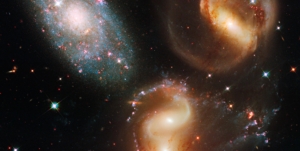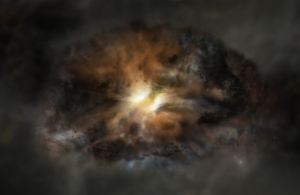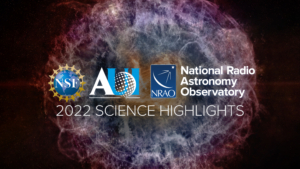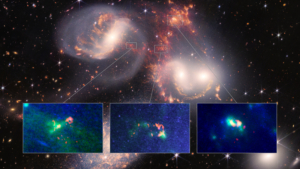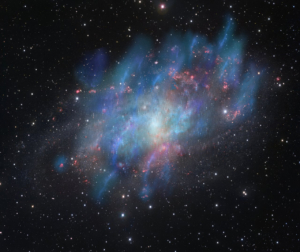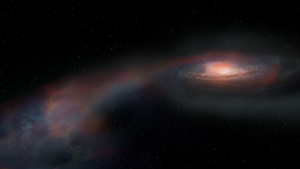Radio astronomers have observed galaxies billions of light years away. But how do they know just how far away those galaxies are?
Extreme Galaxy Reveals Clues to Early Supermassive Black Hole Formation
While studying galaxies in the early Universe with the Atacama Large Millimeter/submillimeter Array (ALMA), scientists discovered one of the most extreme galaxies ever recorded in the early Universe. What’s more, it was hiding a unique supermassive black hole (SMBH). The observations could unlock clues about the early formation of these violent giants and how to find them.
Science Highlights 2022: Black Holes, Pulsars and Turbulence
The Universe is a dynamic and exciting place, with stars, planets, and galaxies being born, dying, and undergoing dramatic changes. In 2022, the telescopes of the National Science Foundation’s National Radio Astronomy Observatory (NRAO) revealed fascinating new details about several of these processes, and we’re giving you a taste of the greatest radio astronomy moments of the year.
ALMA and JWST Reveal Galactic Shock is Shaping Stephan’s Quintet in Mysterious Ways
Shockwaves resulting from the violent collision between an intruder galaxy and Stephan’s Quintet are helping astronomers to understand how turbulence influences gas in the intergalactic medium. New observations with the Atacama Large Millimeter/submillimeter Array (ALMA) and the James Webb Space Telescope (JWST) have revealed that a sonic boom several times the size of the Milky Way has kickstarted a recycling plant for warm and cold molecular hydrogen gas. What’s more, scientists uncovered the break-up of a giant cloud into a fog of warm gas, the possible collision of two clouds forming a splash of warm gas around them, and the formation of a new galaxy. The observations were presented today in a press conference at the 241st meeting of the American Astronomical Society (AAS) in Seattle, Washington.
VLA Finds Cosmic Rays Driving Galaxy’s Winds
VLA observations revealed that cosmic rays can play an important role in driving winds that rob galaxies of the gas needed to form new stars. This mechanism may be an important factor in galactic evolution, particularly at earlier times in the history of the universe.
ALMA Witnesses Deadly Star-Slinging Tug-of-War Between Merging Galaxies
While observing a newly-dormant galaxy using the Atacama Large Millimeter/submillimeter Array (ALMA) and the Hubble Space Telescope (HST), scientists discovered that it had stopped forming stars not because it had used up all of its gas but because most of its star-forming fuel had been thrown out of the system as it merged with another galaxy. The result is a first for ALMA scientists. What’s more, if proven common, the results could change the way scientists think about galaxy mergers and deaths.






